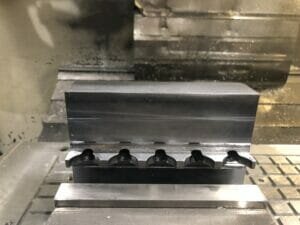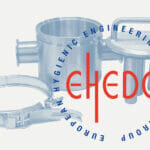As one of Europe’s largest manufacturers of aerospace components, Gardner Aerospace places huge levels of pride in its precision, quality and cost-efficient streamlined manufacturing. It is for these reasons the company with manufacturing facilities around the globe has opted for cutting tool support from MSC Industrial Supply Co.
At the Broughton manufacturing site in North Wales, Gardner Aerospace manufactures structural components for aerospace OEMs from a variety of material types. To ensure the most efficient method of production, and that cost-effective solution is integrated into the business, the Broughton facility has in the last 12 months instigated a working relationship with MSC. The introduction of the MSC regional applications engineer Stuart Wiezniak to Gardner Aerospace was a decision based upon trust and reputation, with Stuart already yielding impressive results for Gardner Aerospace at its Hull manufacturing facility.
The new working relationship almost instantly yielded several cost savings and impressive productivity gains as soon as Stuart entered the Broughton site. With MSC’s decades of industry expertise, Stuart, a member of the application team was recently introduced to a troublesome component that with an annual production output of 7920, was tying up a HAAS S20Y turning centre for much of its daily three-shift operation.
The S98 stainless rod-end components with a 30mm diameter sphere required considerable material removal rates to create a flat on each side. On the HAAS, the limited rigidity of the Y-axis milling head and the three-jaw chuck clamping set-up created frequent machine alarms and stopped production. To eliminate this error, free-up machine availability, reduce cycle times and tooling costs, Stuart worked with Gardner to move the process to a Dahlih 4-axis machining centre with a BT40 spindle taper, and develop a fixture to hold and subsequently machine five parts in a single set-up. The results have been nothing short of staggering.
The previous setup on the HAAS turning centre utilised a 16mm diameter ball nose end mill with two indexable inserts, each with two cutting edges. This end mill from one of the world’s leading cutting tool manufacturers ran at 3mm depths of cut with a paltry material removal rate (MMR) of 6.64cm3/min and a feed rate of 246mm/min. By recommending an alternate machine tool, a different workholding configuration and more applicable cutting tools, Gardner Aerospace is now saving more than £37,500 per annum on this one job – and there is scope to add an even larger reduction to the already eye-watering cost saving.
By designing and manufacturing a fixture to clamp five parts, subsequently, machine the parts in a single set-up and then having the insight to utilise the 4th-axis to rotate the parts 180 degrees to machine the opposite side of the sphere, Gardner is realising massive productivity gains. MSC has been integral in this process and subsequently reducing manual intervention, increasing productivity and reducing costs.
From a tooling perspective, Stuart removed the previous indexable ball nosed tool and replaced it with a Dormer Pramet 32mm diameter high-feed end mill with five inserts and four edges per insert. Applying inserts with Dormer’s M6330 coating grade, the MSC expert increased the machining parameters beyond recognition. Running the new rough and semi-finish end mill at a 0.7mm depth of cut and a cutting speed of 180m/min, the MMR leapt from 6.64cm3/min to more than 50cm3/min. This reduced the cycle times from 5 minutes 49 seconds per part to just over 33 seconds.
The strategy applied by the MSC expert utilised the Dormer end mill for the semi-finish process and then complete the task with a larger 50mm diameter button tool. With 26 seconds of rough machining with the Dormer end mill and a seven-second cycle with the finishing tool, the total 33-second cycle has yielded Gardner Aerospace a saving of more than 5 minutes per part, a significant saving considering the annual quantities required. Commenting upon the strategy, MSC’s Stuart Wiezniak says: “The first challenge was to ensure machine availability to move the part from the turning centre to a machining centre. From there, we had the freedom to instigate process changes such as the 5-part fixture for multiple part machining. Devising a platform for rigid machining was the foundation block and once this was in place, we could look closer at tooling strategies and subsequent savings.”
“The beauty of creating partnerships with MSC is that we have access to hundreds of vendors and more than 120,000 product lines, so we are not constrained by a single source tooling supply. This means we can ensure the best tool for the application. In this specific application, the Dormer Pramet 32mm high-feed end mill was the optimal choice for high metal removal rates. For the finishing cycle, the rod end parts require an 8mm radius on the flats, so we opted for a 50mm button tool with four inserts and four cutting edges per insert. Running at a feed rate of 622mm/min with a single ‘finishing pass’ of 0.1mm DoC (depth of cut), the button tool delivers outstanding surface finishes with tool life of 400 parts per cutting edge.”
Summarising on the remarkable savings that have been made on this single process with the rod end parts, Stuart says: “Cutting tool strategies are always a balance of costs versus productivity rates. In this instance, the annual tooling cost increased by £321p/a to £2678, but we have slashed machine hours by 81% from 724 hours to 141 and the cost per part has reduced from £28 to £23. The saving of £37,542 not only absorbs the slight increase in tooling costs, but it also improves process reliability, frees-up machine capacity and man-hours and it improves component quality. We have exceeded customer expectations with regards to meeting the original objective whilst delivering the project goals on-time.”
The next step
Referring back to the ‘equally large cost reduction potential’ on this job, Stuart states: “The rod end parts has two different part families within the 8,000 quantity requirement. Some parts require a 24.8mm diameter bore on the machined flat whilst other parts need a 17.46mm diameter bore. Before the Covid pandemic and the subsequent lockdown, we investigated the possible options, trialled several tools and the results already look impressive. However, whilst we can expect another huge leap in cost savings, we have not yet had the opportunity for final approval with these tools. When the opportunity arises, I’ll be certain to deliver even more fantastic results for Gardner Aerospace.”







